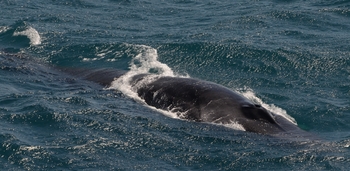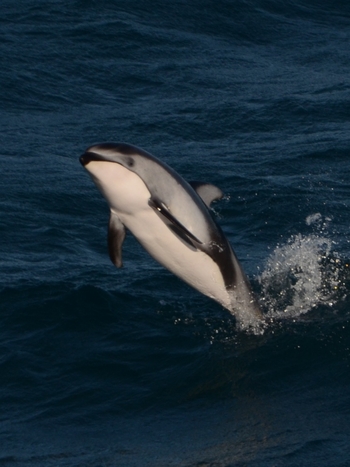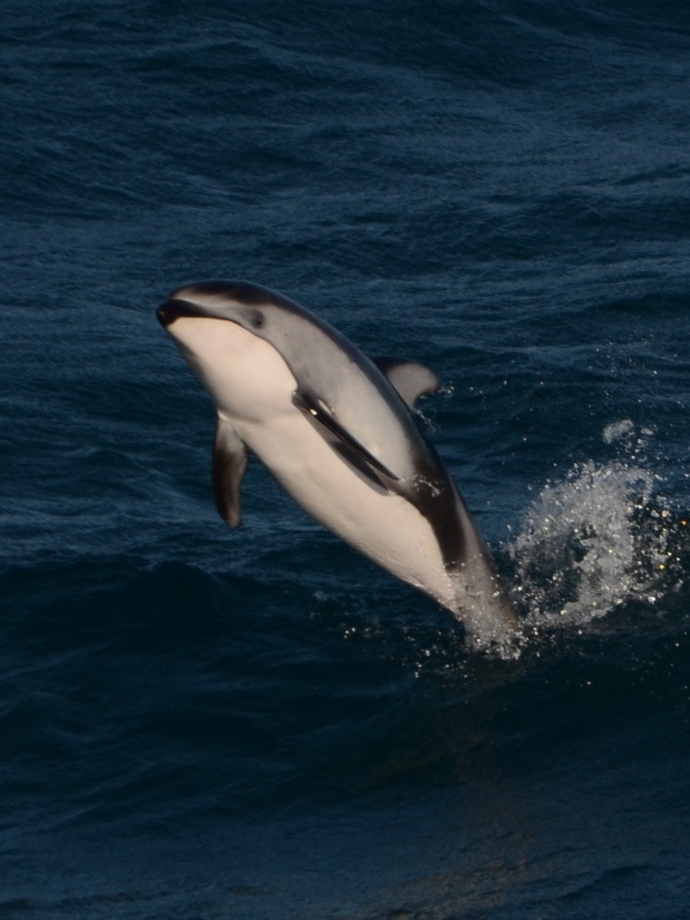
On 5 July 2011, marine mammal observers onboard the TE SubCom Dependable were treated to a close encounter with a Sei whale, the third largest baleen whale.
--Photo by Desray Reeb, marine mammal observer onboard the TE SubCom Dependable

Sei whale

On 5 July we were in the right place and time to encounter a group of approximately 300, or more, Pacific white-sided dolphins. These dolphins remained somersaulting, leaping, porpoising and surfing around the ship for more than 1.5 hours.
--Photo by Suzanne Yin, marine mammal observer onboard the TE SubCom Dependable

Pacific White-Sided Dolphin
We find ourselves on board the TE SubCom Dependable as part of a National Marine Fisheries Service condition for authorization to undertake cable-laying activities. As two qualified marine mammal observers, under the auspices of the Consortium for Ocean Leadership, we are required to stand daily watches, which we conduct from the bridge. We are responsible for providing mitigation of any potential entanglement or harm to all marine mammal species during cable-laying or ship operations.
Since departing the port of Astoria, we have sighted marine mammals every day, consisting mostly of the spritely Dall’s porpoise and the acrobatic Pacific white-sided dolphin. Blows, the exhalation from whales, have been seen as far as 5 km away. A 6 m blow, approximately 3.7 km away belonged to a blue whale (largest living mammal) and a bunch of small, puffy blows, followed by impressive bouts of breaching and fluking (showing their tails), belonged to humpback whales. Identification images of the blue whale and one of the humpback whales were taken and attempts will be made to match these individuals to existing identification catalogs.
On 5 July we were treated to a close encounter with a Sei whale, the third largest baleen whale. Shortly after that exciting opportunity, we were in the right place and time to encounter a group of approximately 300, or more, Pacific white-sided dolphins mixed with Northern right whale dolphins. The very unique-looking, dorsal fin-less, Northern right whale dolphins disappeared within a few minutes, while the Pacific white-sided dolphins remained somersaulting, leaping, porpoising and surfing around the ship for more than 1.5 hours.
On several occasions we have seen Northern fur seals and Steller’s sea lions. Black-Footed Albatross, Fork-Tailed and Leach’s Storm Petrels, Northern Fulmars, Western Gulls, Murres, Short-tailed and Sooty Shearwaters and Tufted Puffins have also kept us company. To date, at least 6 cetacean species have been identified and will hopefully increase as the cruise continues. As of today, no operational delays have been necessary due to potential endangerment of marine mammals.
--Suzanne Yin and Desray Reeb are serving as Marine Mammal Observers onboard the TE SubCom Dependable during installation of the OOI backbone cable.

